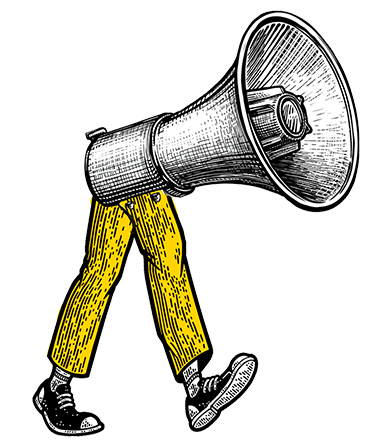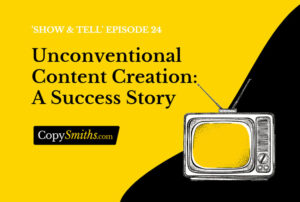Home » Content Marketing » Compelling Words That Lead to Increases in CTA Clicks and Conversions

Compelling Words That Lead to Increases in CTA Clicks and Conversions
A call-to-action is one of the key reasons to create interesting online content. It’s a prompt that leads to a conversion, telling your readers what you want from them.
CTAs make your audience commit to your offers once they’ve taken in your content.
Basically, your content marketing depends on how clickable your CTAs are.
You should have many CTAs in every piece of content you create. And these CTAs can take many different forms in terms of blog/website placement and design.
You can have CTAs:
- At the top of your page: Displayed in a static bar that remains visible as readers scroll down
- On the sidebar: Where you can have simple capture forms and ads about your products
- As a popup or slider: Appearing on the reader’s screen when prompted or at a specified point
- Above the fold: Visible on the top half of your page without your audience needing to scroll down
- In-line: Displayed as links to click within your article
CTAs also come in different mediums like social media posts, videos, and landing pages. Which all convey a specific message to your readers and tell them about what you’re offering.
If you’re not using CTAs on your online platforms, then you’re missing out on an incredible number of customers. Readers will likely act on a prompt if they’re given one.
But creating CTAs doesn’t always guarantee huge conversion rates. You can design them in captivating ways with placement and visual content. But that’s only part of the process to greater conversions.
The other important part you need for high conversions is knowing how to phrase them. You need to know which words will increase the number of CTA clicks.
Verbs to Start With
When crafting your CTAs, you want to start with strong action verbs. Let your audience know exactly what they need to do and don’t be vague about it.
You want your CTAs to grab attention. You don’t want readers questioning whether they should click.
There’s a big difference between a question or suggestion and a prompt.
Take for example:
- If you’d like, follow us here
- Do you want to buy X?
- Enroll now!
How do readers react to each option
- Option 1 allows room for hesitation and comes off as a timid attempt to gain followers. Many readers won’t click that.
- Option 2 is a question. You don’t want your audience to question your CTA. They already came with questions of their own. You’ve likely already lost them if this is the case. You might get very few clicks but you’re missing out on so many others.
- Option 3 is direct. It grabs attention. Your audience knows exactly what to do. This CTA has authority. Readers who came to your page with questions on a topic now have direction in getting answers. And people crave direction.
Your audience expects CTAs. Calls-to-action have been around since way before the internet.
You also want to keep your CTAs short and simple so that your readers don’t lose interest.
So start with a compelling verb that makes your audience want to take action.
Effective verbs to start with include:
| Start | Join |
| Save | Discover |
| Enroll | Sign up |
| Find | Install |
| Buy | Contact |
| View | Create |
Phrases With Urgency
When giving your audience a prompt, you want them to act on it immediately. Not later or after they’ve given it some thought.
Now! While they’re still interested in your content. Otherwise, they’ll lose interest and you’ll lose a chance at a conversion.
For that, you need to create urgency and motivate your readers.
And there’s no better instigator for individuals to act than the fear of missing out (FOMO).
CTAs are all about evoking emotions. You want your readers to feel like:
- The chance to act is now or never
- Your offer is the answer they’ve been looking for so they shouldn’t wait any longer
- If they don’t click, someone else will, who will then enjoy your offer instead
Using references to time is a smart way of creating the urge to act. And adding an exclamation mark gives your CTAs a more dramatic effect.
You can use numbers or words such as:
| Closing soon! | Now! |
| 24-hour offer! | Deadline |
| One-time offer! | Hurry! |
| Limited time only! | Urgent! |
| Offer ends on the Xth! | Today! |
| Last chance! | Immediately! |
Perfecting your eCommerce copywriting skills is achievable with the Small Revolution School. Take the bundled ‘Copywriting for eCommerce Clients’ course.
Learn how to write powerfully. Enroll today!
Phrases That Appeal
When your readers come across a call-to-action, it should appeal to them. They want to click because this is what they feel is right for them.
The benefits you display in your content and CTAs need to convince your audience.
Your CTAs can appeal to your readers when you create a sense of exclusivity or hope.
Exclusivity makes your audience feel special. Like they’re the only ones or part of the lucky few to enjoy your offer.
And for exclusivity to work, your offer needs to amaze. It needs to be unique and compelling enough that your readers will want in at any cost.
Use phrases that describe what your readers will become or what they’ll gain once they click. Phrases like:
| Only X spots left | While stocks last |
| Special offer | Pre-order |
| Advanced | Exclusive |
| Featured | Limited supply |
| Subscribers only | Members-only |
| Access | Secret |
Hope gives your audience relief from a challenging issue they’re facing.
They’ve come to you desperate for answers and you need to emphasize the issue and how big it is. Then the hope you create through your CTA will convince them that it’s the next logical step to take.
To sell something to your audience, they must first need to have it.
State the problem and how critical it is, then present your solution: the hope they always needed.
A great way to convince your readers that “This here is the right choice” is to provide guarantees. This creates trust and it’s always easier getting a conversion when people trust you.
Your guarantees can be in reference to quality, lack of risk, or a timeframe for expected results. Use words like:
| Proven | Risk-free |
| Results within X days/weeks/months | Free |
| Best | Safe choice |
Coming up with content that consumers want to read can seem like a challenge.
There’s a lot that goes into creating blog posts. But it is achievable if you follow simple and proven steps in the Small Revolution School
Get Clicks
Now you know which words can increase your conversion rate. This improves a significant part of your content marketing strategy.
But content marketing is so much more than crafting CTAs and writing articles you think people will like.
It’s writing a lot and at a consistent level of quality. It’s creating a great deal of content to show expertise in your field. Expertise that your audience and search engines will recognize and appreciate.
CopySmiths
I'm Katrina McKinnon, founder of CopySmiths and Small Revolution. In my 20 years of experience, I have helped online businesses create high-performing content specifically on an eCommerce store's blog. Find me on LinkedIn and Twitter.

CopySmiths offers the best blog writing services for online stores.
If you'd like us to write blog articles for you, click here.
Most Recent
- 3 Bold Questions You Should Ask When Hiring A Content Writer

- 5 Practical Reasons You Should Use a Blog Post Template

- 4 Amazing Benefits of Using a Title Generator for New eCommerce Blogs

- 10 Awesome Bio Examples Your Online Store Blog Should Emulate

- 8 Basic Steps to Successful Content Development Every Time

Podcasts
Got a question?
Ask our friendly team about our article writing services.
Subscribe to CopyZine
Monthly, hand-picked stories of the best in eCommerce Content.




